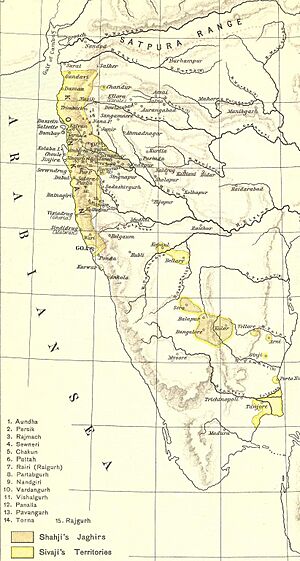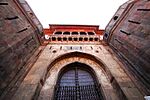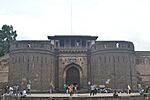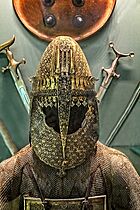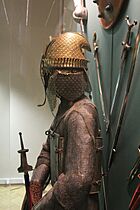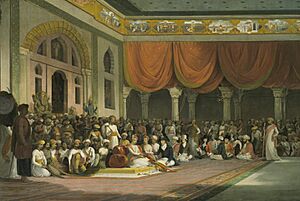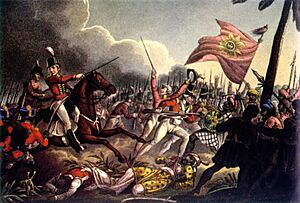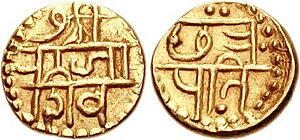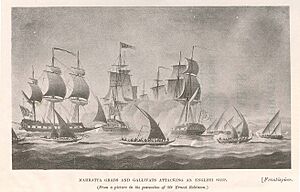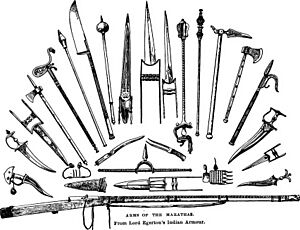Maratha Confederacy facts for kids
Quick facts for kids
Maratha Confederacy
Maratha Empire |
|||||||||||
|---|---|---|---|---|---|---|---|---|---|---|---|
| 1674–1818 | |||||||||||
|
Royal Seal of Shivaji I
|
|||||||||||
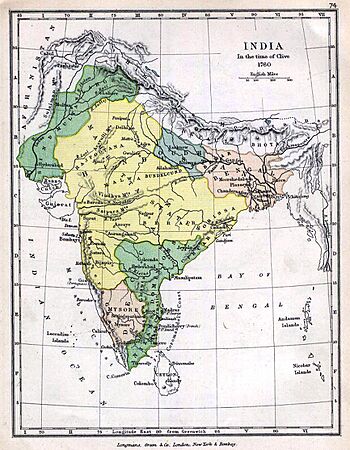
The Maratha Confederacy and controlled regions in 1760 near its peak (yellow)
|
|||||||||||
| Capital | Royal seat:
Peshwa's seat: Poona (1728–1818) |
||||||||||
| Official languages | |||||||||||
| Religion | State religion: Hinduism Other: Other religions in South Asia |
||||||||||
| Government | Absolute monarchy (1674–1731) Federal oligarchy with a restricted monarchial figurehead (1731–1818) |
||||||||||
| Chhatrapati | |||||||||||
|
• 1674–1680 (first)
|
Shivaji I | ||||||||||
|
• 1808–1818 (last)
|
Pratap Singh | ||||||||||
| Peshwa | |||||||||||
|
• 1674–1683 (first)
|
Moropant Pingle | ||||||||||
|
• 1803–1818 (last)
|
Baji Rao II | ||||||||||
|
• 1858–1859
|
Nana Saheb (claimed titular) | ||||||||||
| Legislature | Ashta Pradhan | ||||||||||
| History | |||||||||||
|
• Coronation of Shivaji
|
6 June 1674 | ||||||||||
|
• Deccan Wars
|
1680–1707 | ||||||||||
|
• Recognition of Shahu I as the legitimate ruler by Bahadur Shah I
|
1707 | ||||||||||
|
• Appointment of Balaji Vishwanath as hereditary Peshwa
|
1713 | ||||||||||
|
• Treaty of Bhopal
|
1737 | ||||||||||
| 1817–1819 | |||||||||||
|
• Dissolution of the Maratha Confederacy
|
1818 | ||||||||||
| Area | |||||||||||
| 1760 | 2,500,000 km2 (970,000 sq mi) | ||||||||||
| Currency | Rupee, Paisa, Mohur, Shivrai, Hon | ||||||||||
|
|||||||||||
| Today part of | India | ||||||||||
The Maratha Confederacy, also known as the Maratha Empire, was a powerful kingdom in the Indian subcontinent. It was made up of the lands ruled by the Peshwa (like a prime minister) and four other important Maratha states. The empire began in 1674 when Shivaji was crowned as the Maratha Chhatrapati (king).
The Emperor Bahadur Shah I officially recognized the Marathas in 1707 after a long fight. Even though the Marathas grew very strong, they still respected the Mughal emperor as a symbolic leader. From 1737 to 1803, the Marathas had a big influence on politics in Delhi.
Shivaji came from the Maratha community. However, his government included brave warriors and smart leaders from many different Marathi groups in what is now Maharashtra. Shivaji's kingdom, first called the Maratha Kingdom, grew much larger in the 1700s. This happened under the leadership of Peshwa Bajirao I. The Marathas were a Marathi-speaking farming group from the western Deccan Plateau. They became famous by creating Hindavi Swarajya, which means "self-rule of Hindus."
Contents
History of the Maratha Empire
Shivaji and Early Rulers

Shivaji (1630–1680) was a Maratha leader from the Bhonsle family. He founded the Maratha state. In 1645, Shivaji started a rebellion against the Sultanate of Bijapur. He captured the Torna fort and many others, taking control of the area. He created an independent Maratha state with Raigad as its capital. He also fought against the Mughals to protect his kingdom. In 1674, he was crowned as Chhatrapati (king) of the new Maratha Kingdom.
When Shivaji died, his kingdom covered about 4% of India. It had around 300 forts and an army of 40,000 cavalry and 50,000 soldiers. He also had a navy along the west coast. Over time, the kingdom grew even bigger. By the early 1700s, under his grandson and later the Peshwas, it became a huge empire.
Shivaji had two sons, Sambhaji and Rajaram. In 1681, Sambhaji became king after his father's death. He continued to expand the kingdom. Mughal Emperor Aurangzeb moved his large army south in 1681 to fight the Marathas. For eight years, Sambhaji successfully led the Marathas against the Mughals.
In 1689, Sambhaji was captured by Mughal troops and later executed. After Sambhaji's death, his half-brother Rajaram became king. Rajaram had to flee to Gingee for safety. From there, Maratha commanders like Santaji Ghorpade and Dhanaji Jadhav raided Mughal lands and recaptured many forts. Rajaram died in 1700. His wife, Tarabai, took control for her young son, Shivaji II.
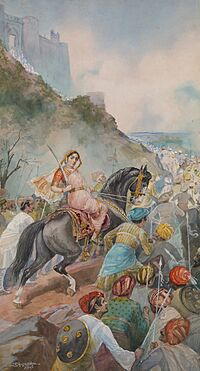
After Aurangzeb died in 1707, Shahu, Sambhaji's son and Shivaji's grandson, was released by the new Mughal emperor. Shahu claimed the Maratha throne, which led to a conflict with Tarabai. This resulted in two rival Maratha governments: one in Satara (led by Shahu) and one in Kolhapur (led by Tarabai). Shahu appointed Balaji Vishwanath as his Peshwa. The Peshwa helped Shahu get Mughal recognition as the rightful Maratha king.
During Shahu's rule, Maratha generals expanded the kingdom in different directions. Raghoji I Bhonsle expanded east, Khanderao Dabhade expanded west into Gujarat, and Peshwa Bajirao expanded north.
The Powerful Peshwa Era
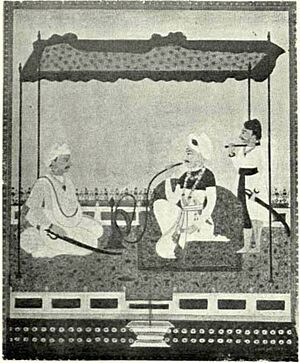
In 1713, Shahu appointed Balaji Vishwanath as Peshwa. Balaji Vishwanath made an important agreement with Kanhoji Angre, a strong naval chief. In 1719, Maratha forces under Balaji marched to Delhi and helped remove the Mughal emperor, Farrukhsiyar. The new emperor gave Shahu the right to collect taxes (Chauth and Sardeshmukhi) from six Mughal provinces.
After Balaji Vishwanath died in 1720, his son, Baji Rao I, became Peshwa. Bajirao is famous for making the Maratha Kingdom ten times larger between 1720 and 1740. In 1728, the Marathas defeated the Nizam of Hyderabad in the Battle of Palkhed, showing their strong military strategy. In 1737, Bajirao I's forces raided Delhi. The Nizam tried to help the Mughals but was defeated in the Battle of Bhopal. The Marathas gained a lot of wealth and control over Malwa. They also won the Battle of Vasai against the Portuguese.
Bajirao's son, Balaji Bajirao (Nanasaheb), became the next Peshwa. In 1740, Maratha forces under Raghoji Bhonsle defeated the Nawab of Arcot in the south. This greatly increased Maratha influence there. Raghoji also led several expeditions into Bengal from 1741 to 1748. These campaigns caused hardship for the local population and led to the decline of the Nawabs of Bengal. The Marathas demanded payments, which caused suffering for those who could not pay.
Raghoji successfully took control of Odisha permanently. In 1751, the Nawab of Bengal made peace with Raghoji, giving him Cuttack (Odisha) and agreeing to pay 1.2 million rupees annually as Chauth for Bengal and Bihar.
Balaji Bajirao helped farming and protected villagers, improving the state of the land. His brother, Raghunath Rao, captured Delhi in 1757, defeating the Afghan army. This set the stage for Maratha control over North-west India. After the 1758 Battle of Attock, the Marathas captured Peshawar.
Before the Third Battle of Panipat in 1761, the Marathas took valuables from the "Diwan-i-Khas" in the Red Fort of Delhi. This was a place where Mughal emperors met important guests.
In 1760, the Marathas, led by Sadashivrao Bhau, sent a large army north to fight the Afghans. This army, joined by forces from Holkar, Scindia, and Gaekwad, recaptured Delhi in August 1760. By 1760, Maratha power was at its strongest, covering over 2.5 million square kilometers.
Ahmad Shah Durrani gathered allies to fight the Marathas. On January 14, 1761, huge armies clashed in the Third Battle of Panipat. The Maratha Army lost the battle, which stopped their expansion. The Jats and Rajputs did not support the Marathas. Some historians say this was because the Marathas had taxed them heavily and interfered in their affairs.
Peshwa Madhavrao I was the fourth Peshwa. He worked to unite the Confederacy. He sent generals to the north to re-establish Maratha power. Madhav Rao I defeated Hyder Ali of Mysore in 1767.
In 1771, Mahadaji Shinde recaptured Delhi and placed Shah Alam II back on the Mughal throne as a puppet ruler. The Marathas also sent an army in 1772 to punish the Afghan Rohillas for their role in Panipat. They took control of Rohilkhand.
Madhav Rao died in 1772 at age 27. His death was a big blow to the Maratha Confederacy. After this, Maratha power began to decline.
The Confederacy Era and British Influence
After Peshwa Madhavrao I died, the empire became more like a confederacy, with powerful regional chiefs. Under Mahadaji Shinde, the ruler of Gwalior, the Marathas defeated the Jats and Rohilla Afghans. They took Delhi, which remained under Maratha control for the next thirty years. Shinde helped bring back Maratha power after the defeat at Panipat.
In 1787, the Marathas fought Tipu Sultan of Mysore in the Battle of Gajendragad and won. This extended Maratha territory to the Tungabhadra river. In 1783, Mahadaji captured the strong fort of Gwalior.
In 1788, Mahadaji's armies defeated Ismail Beg, a Mughal noble. The Rohilla chief Ghulam Kadir took over Delhi and blinded King Shah Alam II. Mahadaji intervened, killed Ghulam Kadir, and restored Shah Alam II to the throne. The Marathas also defeated the Nizam of Hyderabad's armies in 1795 at the Battle of Kharda.
Conflicts with Mysore
The Marathas often fought with Tipu Sultan and his Kingdom of Mysore. The Maratha–Mysore War (1785–1787) ended with Tipu Sultan's defeat. He had to pay a large war cost and an annual tribute to the Marathas.
In 1791, some Maratha irregular troops caused damage to the Sringeri temple. The head priest, Shankaracharya, asked Tipu Sultan for help. Tipu Sultan expressed his sadness and anger at the news. He immediately ordered help for the Swami. Tipu Sultan continued to show interest in the Sringeri temple for many years.
The Maratha Confederacy later joined with the British East India Company against Mysore in the Anglo-Mysore Wars. Maratha cavalry helped the British defeat Mysore in the Fourth Anglo-Mysore War in 1799. After Mysore was conquered, the Marathas sometimes raided the region to gain compensation for past losses.
British Intervention and Decline
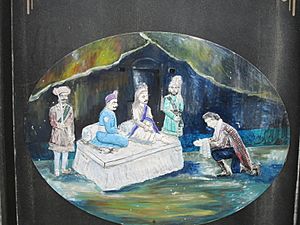
In 1775, the British East India Company got involved in a power struggle in Pune. They supported Raghunathrao to become Peshwa. The British also wanted to prevent any alliance between the Marathas and the French. Maratha forces defeated a British army at the Battle of Wadgaon. The First Anglo-Maratha War ended in 1782, restoring the situation before the war.
In 1799, Yashwantrao Holkar became King of the Holkars. He rebelled against Peshwa Baji Rao II. In 1802, he marched on Pune and defeated the Peshwa. The Peshwa then sought protection from the British East India Company.
This led to the Second Anglo-Maratha War (1803–1805). The Marathas lost influence over Delhi. This war was the last serious challenge to the British in India.
Finally, the Third Anglo-Maratha War (1817–1818) led to the end of Maratha independence. The British gained control of most of the Indian subcontinent. The Peshwa was sent away to Bithoor with a pension. The Maratha heartland, including Pune, came under direct British rule. Some Maratha states like Gwalior, Indore, and Nagpur became princely states under British control.
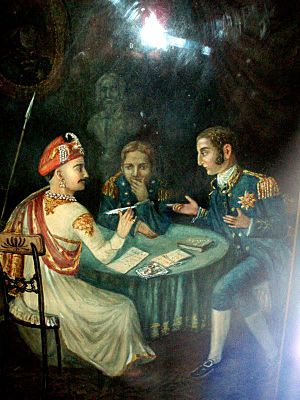
The Maratha warlords fought separately in the Third Anglo-Maratha War and surrendered one by one. By 1818, the British East India Company was in control of almost all of India south of the Sutlej River.
Government and Military
How the Maratha Empire was Run

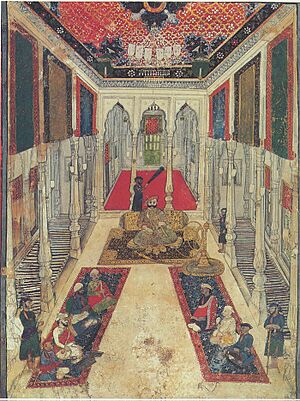
Shivaji set up a council of eight ministers called the Ashtapradhan (The Council of Eight). These ministers helped him run the Maratha Kingdom. Their titles came from the Sanskrit language:
- Peshwa or Pantpradhan – The Prime Minister, who managed the empire.
- Amatya or Mazumdar – The Finance Minister, who handled the empire's money.
- Sachiv – The Secretary, who wrote royal orders.
- Mantri – The Interior Minister, who managed internal affairs and intelligence.
- Senapati – The Commander-in-Chief, who led the army and defense.
- Sumant – The Foreign Minister, who handled relations with other rulers.
- Nyayadhyaksh – The Chief Justice, who handled legal matters.
- Panditrao – The High Priest, who managed religious affairs.
- Chitnis - The Personal Secretary to the Chhatrapati.
Most of these ministers also held military commands. Their assistants handled their civil duties. Later, these assistants formed the main part of the Peshwa's government.
The Peshwa was like a modern Prime Minister. Shivaji created this role to help with administration as the kingdom grew. Before 1749, Peshwas held office for about 8-9 years and controlled the army. After 1749, the Peshwa position became hereditary, and they became the real rulers of the Maratha Empire until 1818.
Under the Peshwas, the Maratha Empire grew to control most of the Indian subcontinent. However, it was also under the Peshwas that the empire ended when the British East India Company took control in 1818.
The Marathas had a fair administration policy and allowed everyone to practice their own religion. Shivaji was known as a just and caring king. He believed in a strong connection between the state and its people.
The Marathas also conducted sea raids on Mughal and European trading ships. Europeans called these attacks "piracy." But the Marathas saw them as fair targets because these ships were trading with their enemies. Over time, as agreements were made, attacks on Europeans became less common.
Maratha Military Strength
The Maratha Army under Shivaji was a national army, mostly made up of people from his empire. It was a united force led by regular officers. Later, under the Peshwas, the army included soldiers from different backgrounds, including foreign fighters.
Some historians believe the Maratha Navy helped create the foundation for the modern Indian Navy. Shivaji built many sea forts and warships in the 1600s. These ships were built locally without foreign help. In the 1700s, Admiral Kanhoji Angre built many dockyards along the western coast of Maharashtra. The Marathas also built many hill forts across western Maharashtra.
The Marathas were good at using new military technology. However, they struggled with managing their command structure. This meant that political divisions often weakened their overall strength.
What Others Said About the Maratha Army
Many enemies of the Maratha Empire, including the Duke of Wellington and Ahmad Shah Abdali, praised the Maratha Army, especially its infantry (foot soldiers). After the Third Battle of Panipat, Abdali was relieved because the Maratha Army had almost defeated his forces. He wrote that his victory was only due to divine blessings, and any other army would have been destroyed by the Marathas that day.
Arthur Wellesley, 1st Duke of Wellington, who later became the Prime Minister of Britain, also respected the Maratha infantry. He said they were as good as European soldiers. He warned other British officers not to underestimate them. He noted that Marathas used their cavalry to disrupt enemy supplies. Once the enemy retreated, they would use their infantry and artillery to attack. He advised never to let Maratha infantry attack head-on.
Wellesley Charles Metcalfe, a British official, wrote in 1806 that India had only two great powers: the British and the Marathas. He believed that if the British retreated, the Marathas would take their place.
After the Third Anglo-Maratha War in 1818, the British listed the Marathas as one of the "martial races" to serve in the British Indian Army.
Important Leaders
Royal Houses
Satara Branch:
- Shahu I (1708–1749) (also known as Shivaji II, son of Sambhaji)
- Ramaraja II (1749–1777) (grandson of Rajaram and Queen Tarabai)
- Shahu II (1777–1808)
- Pratap Singh (1808–1839) – signed a treaty with the East India Company.
Kolhapur Branch:
- Tarabai (1675–1761) (wife of Rajaram) ruled for her son Shivaji II.
- Shivaji II (1700–1714)
- Sambhaji II (1714–1760)
- Shivaji III (1760–1812)
Peshwas (Prime Ministers)
- Moropant Trimbak Pingle (1657–1683)
- Nilakanth Moreshvar Pingale (1683–1689)
- Ramchandra Pant Amatya (1689–1708)
- Bahiroji Pingale (1708–1711)
- Parshuram Trimbak Kulkarni (1711–1713)
Peshwas from the Bhat Family (who held real power)
- Balaji Vishwanath (1713–1720)
- Bajirao (1720–1740)
- Balaji Bajirao (1740–1761)
- Madhavrao Peshwa (1761–1772)
- Narayanrao Bajirao (1772–1773)
- Raghunathrao (1773–1774)
- Sawai Madhava Rao II Narayan (1774–1795)
- Baji Rao II (1796–1818)
Main Maratha Confederacy Families
- Holkars of Indore
- Scindias of Gwalior
- Gaekwads of Baroda
- Bhonsles of Nagpur
- Bhonsles of Thanjavur
- Pawars of Dewas and Dhar
- Patwardhans
- Bhoites of Jalgaon, Aradgaon
- Newalkars of Jhansi
- Vinchurkars
Images for kids
See also
 In Spanish: Imperio maratha para niños
In Spanish: Imperio maratha para niños
- List of battles involving the Maratha Confederacy
- Maratha titles




